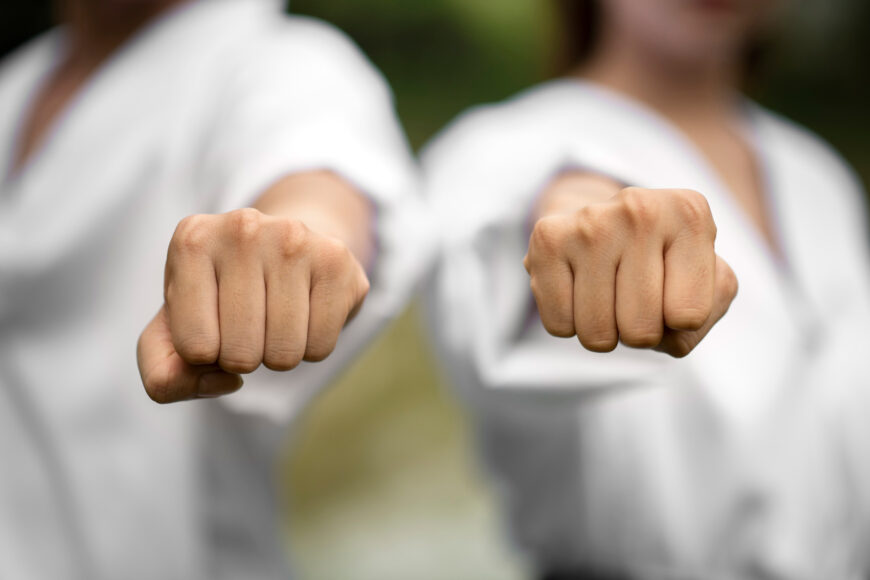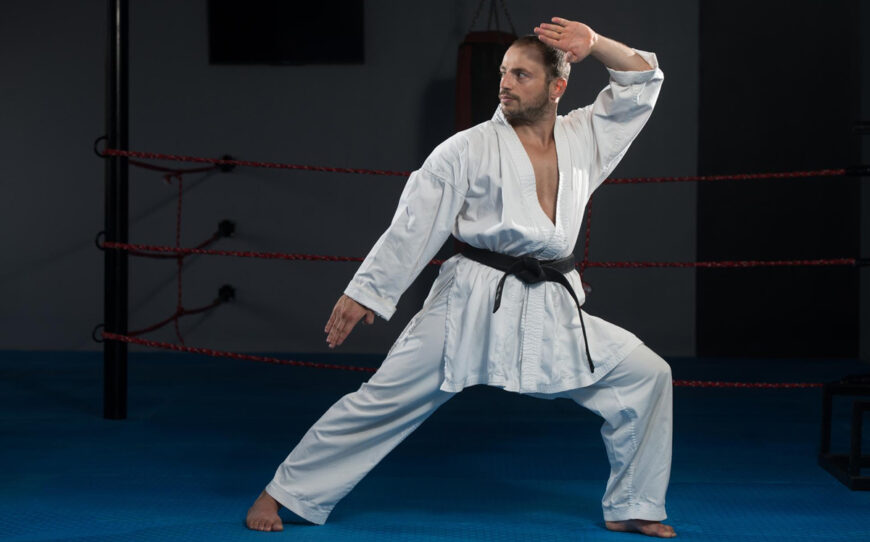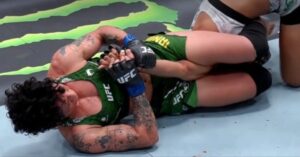Are you intrigued by the world of martial arts and ready to embark on your own karate journey? This essential guide offers beginners a solid starting point for mastering eight fundamental karate moves.
From powerful punches to agile kicks, these techniques form the foundation of this ancient Japanese art form that not only teaches self-defense but also fosters physical fitness and mental focus.
Key Takeaways
- Karate is a diverse martial art with various styles practiced around the world, each with its unique techniques and philosophies.
- The basic fundamentals of Karate can be best understood by breaking down the martial art into three key components: Kihon, Kata, and Kumite.
- Beginners should focus on mastering eight fundamental karate moves such as punches, kicks, and blocking techniques to set themselves on the path towards becoming proficient karateka.
- Regular practice combined with proper form ensures that beginners in karate not only develop strong mind-body coordination but also learn effective self-defense tactics rooted in Japanese history & culture across various circumstances.
Understanding The Basics of Karate
Karate is a martial art that originated in Japan and involves striking with punches, kicks, and blocks; it has many different styles with their own unique techniques and philosophies.
Different Styles of Karate
Karate is a diverse martial art with various styles practiced around the world, each with its unique techniques and philosophies. Here are some of the most popular styles of karate:
- Shotokan: Considered the first modern style of karate, Shotokan emphasizes steady, powerful movements and focuses on stability in all stances.
- Goju-Ryu: Incorporating Chinese Kempo techniques, Goju-Ryu combines hard linear moves with soft circular ones for an effective approach to self-defense.
- American Freestyle: A western-style that takes aspects from traditional karate and merges them with other martial arts disciplines, creating a diverse and challenging system.
- Full-Contact Karate: This style puts emphasis on powerful strikes and knockdowns during sparring sessions to simulate real-world self-defense scenarios.
- Sport Karate: Focused on competitive tournaments and point-scoring techniques, sport karate prioritizes speed and agility over power.
As an aspiring karateka or MMA fan looking to understand more about this martial art, familiarizing yourself with these different styles can help you choose the path that best aligns with your interests and goals in martial arts training.
Read also: The Karate Belt Order, Colors, And Ranking System
Basic Fundamentals of Karate
The basic fundamentals of Karate can be best understood by breaking down the martial art into three key components: Kihon, Kata, and Kumite. Kihon refers to mastering the foundational techniques such as punches, blocks, kicks, and stances which lay the groundwork for any aspiring martial artist.
Kata is a choreographed sequence or pattern that combines various karate moves into a performance meant to simulate combat against multiple opponents. By practicing kata diligently and repetitively under an instructor’s guidance or through online courses like GMAU Shotokan Karate program for beginners – students improve their balance, power output in strikes/blocks/kicks & overall technique efficiency.
Lastly but equally crucial is Kumite – this element involves live sparring sessions where practitioners test their skills against one another while focusing on timing & strategic maneuvering alongside proper counterattacks using different blocks such as Age Uke (rising block) & Soto Uke (outer middle block).
The Building Blocks of Karate: 8 Basic Karate Moves For Beginners
In this section, we will cover the essential building blocks of karate for beginners. From making a proper fist to executing eight basic moves such as punches, kicks, and blocking techniques, you’ll have an overview of what it takes to get started on your karate journey.
Making A Proper Fist

Making a proper fist is the foundation of effective and safe karate practice. It is crucial for executing moves such as punches and blocks without causing injury to oneself.
To create a solid karate fist, start by extending your fingers, then curl them tightly into the palm of your hand, ensuring that your thumb wraps securely around the outside of your fingers.
One essential aspect of making a correct fist is focusing on using the two largest knuckles – those of the index and middle fingers – during impact. To do this, align these knuckles with the centerline of an imaginary opponent’s chest while maintaining proper wrist alignment.
Remember to incorporate kiai, or loud shouts, upon impact to focus energy and intimidate opponents further.
Punching Techniques
Learn the proper way to execute two essential punching techniques in karate – the straight punch (Choku Zuki) and front lunge punch (Oi Zuki) – and discover how these moves can enhance your striking power and self-defense abilities.
The Straight Punch: Choku Zuki
The straight punch, also known as Choku Zuki in Japanese, is a fundamental technique that every karate beginner should master. To execute the straight punch, start by making a proper fist with your dominant hand and aligning your forearm with your knuckles.
Thrust your arm forward from the shoulder with full extension and focus on maintaining a tight fist and wrist alignment throughout the motion. The straight punch is typically aimed at an opponent’s solar plexus, nose or chin, and requires proper body shifting and breathing to generate power.
Remember to keep other techniques like kicks or blocks in mind when using this technique for sparring purposes.
The Front Lunge Punch: Oi Zuki
The front lunge punch, or Oi Zuki, is a core technique in Karate for beginners. This technique involves lunging forward with one leg while punching with the opposite arm.
To execute this move correctly, keep the back heel down and rotate your hips and shoulders to extend your arm fully towards the target. This punch generates more power than the straight punch but puts you in a rooted position for a few seconds.
It’s important to practice this move repeatedly to master it as it sets you up for advanced techniques like jump kicks and spin kicks.
Kicking Techniques
The front kick, side kick, and roundhouse kick are important kicking techniques in karate.
The Front Kick: Mae Geri
The front kick, or Mae Geri in Japanese, is one of the fundamental kicking techniques in karate. This move involves lifting the knee and extending the leg forward to strike with either the ball of the foot or heel.
Proper form requires chambering the knee towards your chest before quickly extending it outwards while maintaining balance and stability. The front kick can be targeted at various areas such as your opponent’s groin, stomach, chest, or face depending on their position and vulnerability.
Beginners should start practicing this technique slowly and with proper form first before increasing speed and power for maximum effectiveness in sparring or self-defense situations.
The Side Kick: Yoko Geri
One of the most essential and effective attacks in karate for beginners is the side kick, or Yoko Geri. With correct execution, this move can be a powerful tool both offensively and defensively.
The side kick targets an opponent’s ribs or knees, making it an excellent offensive technique. Also, when used defensively, it acts as a barrier against incoming attacks and provides enough force to push attackers away.
To execute a proper Yoko Geri, martial arts students must maintain good balance while extending their legs sideways with maximum power before retracting them quickly into position.
Kiai shouting is highly recommended to focus energy and intimidate opponents during the attack.
The Roundhouse Kick: Mawashi Geri
The roundhouse kick, or Mawashi Geri, is a powerful and versatile technique in karate that can be used to attack at different heights. This kick involves rotating the hip and extending the leg to strike with the foot or shin.
To practice the roundhouse kick, beginners should start with light, controlled kicks and gradually increase speed and power as they become more confident and skilled. The kick can be practiced on a heavy bag, focus mitts, or with a partner during sparring sessions.
Mastery of basic kicks such as Mawashi Geri builds strength and flexibility through training which can lead to more advanced combinations in karate.
Blocking Techniques
Learn the proper execution of upper rising block, middle block, and downward block to protect yourself from incoming attacks.
Upper Rising Block: Age Uke
The upper rising block, also known as Age Uke, is a basic blocking technique used in karate. It’s designed to deflect attacks coming from above and can be used to launch an immediate counterattack while moving forward.
Age Uke is often performed with one arm extended up and the other guarding the midsection. This technique requires speed, accuracy, and strength to execute correctly. By mastering Age Uke along with other basic blocks and strikes, beginners in karate can progress to more advanced techniques and combinations.
Middle Block: Soto Uke/Uchi Uke
Soto Uke and Uchi Uke are two essential blocking techniques that every beginner in karate should master. Soto uke is an outside-inward block, where the forearm moves from outside to inside, deflecting an opponent’s strike.
On the other hand, Uchi uke is a reverse inward-outward motion that involves striking or deflecting the opponent’s attack with an inward chop-like motion of the arm.
These blocks are particularly useful because they not only deflect your opponent’s attack but also create openings for counterattacks. It is important to remember that when using these middle blocks during sparring sessions or self-defense scenarios, you should always use your forearm instead of your hands to avoid injuring yourself.
Downward Block: Gedan Barai
One of the most important techniques in karate is the Gedan Barai, also known as the downward block. This technique is essential for defending against low attacks such as kicks aimed at your legs or midsection.
To execute this move properly, you need to start in a natural stance and then lower your arm diagonally across your body while twisting your wrist so that your palm faces outward.
It’s essential to master basic moves like Gedan Barai before moving on to more advanced techniques in karate. Proper form and technique are critical for executing these moves safely and effectively.
Also, remember that safety gear should always be worn during sparring sessions because even experienced martial artists can get injured without protective equipment.
Here is great video tutorial for basic blocking techniques:
Karate Stances
Learn basic stances such as Zenkutsu dachi, the front stance and Neko-Ashi Dachi, the cat stance for balance and power; understanding proper stances is crucial in executing karate techniques correctly.
Basic Stances For Beginners
In Karate, stances are a crucial part of executing techniques correctly. Beginners must pay attention to their stances to develop a strong foundation for their training. Here are some basic stances to start with:
- Natural Stance (Shizentai): Stand with feet shoulder-width apart and toes pointing forward.
- Front Stance (Zenkutsu-Dachi): Step one foot forward and bend both knees, keeping the back leg straight.
- Cat Stance (Neko-Ashi-Dachi): Step one foot back and bend the knee slightly, keeping most of your weight on the front foot.
- Horse Riding Stance (Kiba-Dachi): Spread your feet apart wider than shoulder-width and bend both knees as if you were riding a horse.
Remember that balance is key in Karate stances and transitions between them should be smooth without losing balance or stability.
Importance Of Balance And Power In Stances
In Karate, stances are the foundation of executing moves effectively. They provide balance, stability and generate power in strikes and blocks. Proper alignment is critical to effective usage of stances so that the energy from punches, kicks and blocks flow accurately into each action.
Practicing basic stances is fundamental before progressing to higher level forms such as katas or combinations. Holding stances for extended periods improves balance, strength and flexibility while consistent repetition helps align posture further improving capability in martial arts practice overall.
Watch the video tutorial of Karate Basics for Beginners:
Tips For Mastering Karate Moves
To master karate moves, it is important to practice with a partner, focus on form and technique, and emphasize repetition and consistency.
Practicing With A Partner
Practicing karate moves with a partner is essential to improve one’s technique and reflexes. It allows for real-time feedback and helps to understand how punches, kicks, and blocks work in actual combat situations.
While practicing with a partner, beginners should focus on proper form and technique instead of just trying to hit their partner hard.
Furthermore, sparring can help martial arts enthusiasts develop better timing, endurance, speed, and power while providing an opportunity for them to test their skills against someone who will actively try to counterattack.
(Word count: 111)
Focusing On Form And Technique
To become a skilled karate practitioner, mastering the basics is vital. One essential component in honing basic karate moves involves focusing on proper form and technique.
It is crucial to maintain balance and pose during each kick, punch, or block as poor form can lead to injury or ineffective strikes.
Moreover, training with a partner can provide helpful feedback on your form and technique from another perspective. Karate practice must emphasize precision over speed because quicker movements won’t matter if they don’t hit their intended target effectively.
Importance Of Repetition And Consistency
Repetition and consistency are critical components in mastering karate moves. It takes time and persistence to develop the muscle memory needed for effective execution of movements, so consistent practice is key.
Just like with other forms of exercise or training, regular repetition helps to condition the body and mind. The more frequently someone practices a movement, the more naturally it will come to them in competition or self-defense situations later on.
Choosing An Organized Training Program
To take your karate skills to the next level, consider choosing a structured training program such as GMAU Shotokan Karate or find a local school with qualified instructors – by doing so, you’ll be on your way to reaching your martial arts goals.
Selecting A Suitable Course Or Dojo
Choosing a suitable course or dojo is crucial to ensure the proper learning of karate moves. Here are some tips to help you make the right decision:
- Research different styles of Karate and determine which one you would like to learn.
- Look for schools that specialize in teaching beginners, so you can master the fundamentals of karate moves.
- Evaluate the qualifications and credentials of instructors, ensuring they have experience teaching beginner-level students.
- Check the school’s culture and environment to determine if it aligns with your learning style and goals.
- Assess the availability of training schedules and decide if they fit into your daily routine.
- Determine the cost of tuition fees, additional expenses such as uniforms, equipment, and testing fees.
- Take a trial class or observe a regular class before committing to joining any school or dojo.
- Consider online schools that offer structured courses with trained professionals who can guide you through virtual classes.
Remember that selecting a suitable course or dojo plays a significant role in your progress in mastering basic karate moves as a beginner. So take your time, research extensively, ask questions, and choose carefully!
Importance Of Qualified Instructors
One of the crucial factors for beginners in selecting an organized karate training program is choosing a qualified instructor. A competent instructor will provide thorough guidance to new learners, ensure safety, and refine techniques through proper instruction.
Moreover, they can offer invaluable insight into martial arts philosophy and etiquette. Without proper supervision from professional instructors, learners may develop bad habits that can cause injuries or hinder progress.
For example, a beginner should seek out schools or dojos accredited by recognized martial arts associations such as the World Karate Federation (WKF) or International Shotokan Karate Federation (ISKF).
Furthermore, some online programs like GMAU Shotokan Karate offer world-class instruction from experienced professionals with years of training experience so that students can learn at their own pace without missing any critical details.
The Path To Progression
Set personal goals and work towards belt promotions by consistently practicing karate moves, testing progress, and seeking guidance from qualified instructors in a suitable dojo or course.
Setting Personal Goals
Setting personal goals is crucial when learning karate moves for beginners. It helps individuals stay motivated, track progress and work towards a specific target.
For instance, one could aim to master the eight basic karate moves or progress through the belt system.
Through consistent practice, goal setting can lead to long-lasting success in mastering karate techniques. For example, practicing kicks and punches repeatedly until they feel natural may aid in achieving black-belt status over time.
Testing And Belt Promotions
Karate has a well-established belt system that allows students to track their progress and skill improvement. Belt promotions are an essential part of the path to progression in Karate, where students can move up through different levels once they demonstrate mastery of the required skills and techniques for each level.
As beginners, it is crucial to set personal goals in line with the curriculum sections such as stances (Tachikata), punches (Tsuki), blocks (Uke), and kicks (Geri) while working closely with trained professionals like Sensei.
Ensuring safety is also paramount during sparring sessions when working on karate moves as one’s sparring partner is real, not a punching bag. However, reaching higher levels in karate goes beyond just physical strength but involves training the mind as well.
FAQs
1. What are some basic karate moves for beginners?
Beginner karate students often start with fundamental techniques such as punches, kicks, blocks and strikes. These include forward punch, front kick, inside block and backfist strike among others.
2. How long does it take to learn karate?
The time it takes to learn karate depends on various factors such as the student’s effort, dedication and natural abilities. However, consistent training over several years can help develop a strong foundation in the martial art.
3. Is karate a good form of exercise?
Karate is an excellent form of physical exercise that offers numerous health benefits including increased strength, flexibility, balance and cardiovascular endurance. In addition to improving fitness levels, regular practice may also lead to greater mental clarity and focus.
4. Do I need special equipment or clothing to begin learning karate?
While certain supplies like uniforms (gi) and protective gear may be mandatory for advanced training or competition purposes – newcomers don’t require much except comfortable clothes (such as sweatpants/t-shirt), additional padding like gloves & mouth guards not required until more advanced stages where sparring activities become common protocol when participating in class activities/spar ring matches etc.. It’s best consult your instructor regarding any specific attires/equipment you’ll need based upon their program requirements/expectations before starting out though!
Conclusion
Karate is a martial art that requires discipline, focus, and an understanding of fundamental skills. With the eight basic moves outlined in this article, beginners can start their karate journey with confidence.
Remember to practice proper fist formation, aim for the center of your opponent’s chest when striking, and make a loud shout upon impact to maximize your energy output. By mastering these basics through repetition and consistency, anyone can progress towards more complex techniques and achieve their training goals in karate.
Whether you choose to learn at a local or online school like GMAU Shotokan Karate, always remember that karate involves not just training the body but also the mind.









